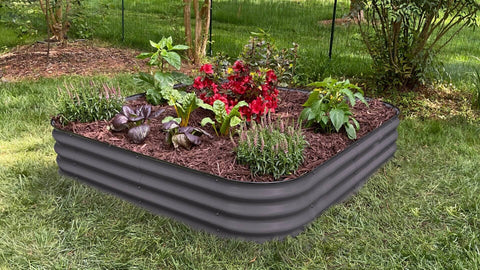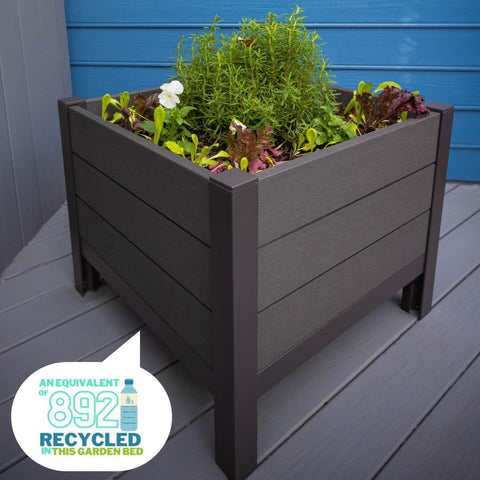
How to Achieve Balance in Floral Design with Your Raised Garden Beds
Floral design is the art of carefully selecting and arranging flowers to create beautiful arrangements. Whether you are decorating your home or planning a special event, achieving balance is essential to creating a visually appealing floral arrangement. With our new raised beds with legs, you can easily incorporate balance into your floral design, introducing another level of dimension to your arrangements.
In this article, we discuss the different types of balance, principles of floral design, and various flower arrangement techniques that can help you achieve balance in your floral design with raised garden beds.
What is Floral Design and Why is Balance Important?

Floral design is the art of arranging flowers in a harmonious and aesthetically pleasing manner. Flower arrangements can vary in size and complexity, and should always reflect the occasion or setting in which they will be displayed.
Balance is a fundamental principle of floral design that can make a world of difference in the way your floral arrangement is perceived. It is crucial to create a sense of balance that will attract the viewer's eye and make your arrangement more appealing. A well-balanced floral arrangement creates harmony and evokes a feeling of tranquility. This balance is even more crucial when dealing with larger planting structures like the Urban Oasis model, which provides ample space for a variety of plants.
Proportion, on the other hand, is a vital aspect of floral design that deals with the relationship between the different elements of the arrangement, such as the flowers, foliage, and container. It is important to ensure that all elements are proportionate to each other, creating a cohesive design that draws the viewer's eye and creates a sense of balance.
Types of Balance

Symmetrical balance is achieved when two sides of an arrangement are mirror images of one another, with equal visual weight on either side of the central axis. This type of balance is common in traditional floral arrangements and creates a sense of formality and stability.
Asymmetrical balance, on the other hand, is achieved when different elements are arranged around a central axis, creating an overall design that is more informal and relaxed. Asymmetrical balance is often used to create a dynamic, visually interesting arrangement that creates a sense of movement and rhythm in floral design. You can experiment with asymmetrical balance when designing layouts in our Elevated Escape garden bed, for example.
Focal points are used to create a sense of balance and attract the viewer's eye to a particular part of the arrangement. A focal point can be created by using a larger flower or adding a unique element such as a Water garden incorporated within the garden bed itself. This not only creates a visually stunning effect, but it also adds a unique dimension to your garden space.
The Principles of Floral Design
When designing floral arrangements, there are several design elements to consider, including color, texture, form, and size. By combining these elements in a thoughtful way, you can create a balanced and visually appealing design. Furthermore, when using Walk in garden fences, these can be decorated with climbing plants or hanging pots, adding an extra dimension to your arrangement.
The axis of a flower arrangement refers to the imaginary line that runs vertically through the center of the arrangement. The visual weight of the various elements in the arrangement should be distributed evenly on either side of the axis to create a sense of balance.
Foliage is also an essential element in floral design that can help create balance. Foliage can be used to fill in gaps or add texture to an arrangement, creating a cohesive and visually appealing design.
Flower Arrangement Techniques for Achieving Balance

The type of vase you choose for your floral arrangement can have a significant impact on the overall balance of the design. A vase that is too small or too large can throw off the balance of the arrangement, while a vase that is the right size and shape will complement the flowers and foliage.
When arranging flowers, it is important to start with the larger flowers and foliage and then place the smaller flowers around them. By carefully positioning each element, you can create a sense of balance and harmony in the design.
Using different shapes, colors, and textures in an arrangement can create a sense of movement and visual interest. Adding unexpected elements to your arrangement, such as a piece of fruit or a succulent, can also create a focal point and attract the viewer's eye.
How to achieve balance with your raised garden beds
Achieving balance in the design of your raised garden beds is essential to create a visually appealing and functional element in your backyard. A balanced garden bed has a harmonious distribution of plants, colors, and textures that can complement each other and create a peaceful and natural environment.
One way to achieve this balance is by using the floral balance principle we just talked about, which consists of choosing plants that have different heights, shapes, and colors. For example, you can select tall plants for the back of your garden bed, medium-sized ones in the middle, and short plants at the front. This arrangement creates a visual depth, adding an extra layer of interest to your garden bed.
Additionally, using different textures, such as grasses, succulents, or flowers, can create a contrasting effect and provide a more dynamic design. Another way to balance your garden bed is by using a color palette that combines different shades and hues of the same color or complementary colors. By doing so, you can create a cohesive and coordinated look that can enhance the beauty of your garden bed.
Finally, when designing your garden bed, consider the space available, the type of plants you want to use, and the sunlight and water requirements. A well-balanced garden bed not only enhances the aesthetic value of your backyard but also promotes the growth and health of your plants.
Conclusion

Overall, achieving balance in floral design is essential to creating a visually appealing and harmonious arrangement. Using raised garden beds can make this process easier and more enjoyable as you experiment with the various types of balance, design elements, and flower arrangement techniques. By using these tips and principles, you can create stunning arrangements that will be sure to impress.
Frequently asked questions
What is floral balance and how important is it in garden beds?
Floral balance refers to the arrangement of flowers and foliage in a way that creates visual stability and flow. It's crucial to achieving a harmonious and aesthetically pleasing garden bed.
What are the basic principles of balance in floral design?
There are two types of balance in floral design: physical balance and visual balance. Physical balance refers to the actual weight distribution of the materials used, while visual balance refers to the way materials are arranged to create visual harmony. Both forms of balance are important in creating a balanced floral design.
What is the difference between radial balance and bouquet-style floral arrangements?
Radial balance refers to an arrangement where the flowers and foliage are arranged around a central point in a circular or spiral pattern. Bouquet-style arrangements, on the other hand, feature a central focal point with flowers arranged in a symmetrical or asymmetrical pattern around it.
How can I create visual balance in my garden beds?
One way to create visual balance is to use similar materials on either side of your design. You can also achieve visual balance by placing larger flowers or foliage on one side and balancing it out with smaller flowers or foliage on the other. Curved lines and good proportion are also important factors in achieving visual balance.
How can I create a focal point in my garden bed?
A focal point can be created by using a large, eye-catching flower or foliage plant. Once you've chosen your focal point, arrange other flowers and foliage around it to create visual flow and stability. The focal point should be the center of attention and draw the eye throughout the garden bed.
How do I maintain balance as my garden bed blooms and grows?
As your garden bed grows and new blooms emerge, it's important to reassess the balance of your design. Be sure to add new blooms and foliage in a way that maintains the overall balance and visual flow of your garden bed.
What types of visual balance can I use in my garden bed?
There are several types of visual balance you can use in your garden bed, including symmetrical balance, asymmetrical balance, and radial balance. Experiment with different types to find what works best for your design.
Can I use a vase or container in my garden bed for added balance?
Yes, using a vase or container in your garden bed can add additional balance and structure to your design. When choosing a vase or container, consider the size and shape of your flowers and foliage to ensure a good fit.
How can I ensure my garden bed has good proportion?
Good proportion is achieved by using flowers and foliage of different sizes in a way that creates balance and visual flow. Consider the size, shape, and color of your plants when arranging them in your garden bed.
What do florists consider when creating a balanced floral design?
Florists consider a variety of factors when creating a balanced floral design, including the colors and textures of flowers and foliage, the size and shape of the container/vase, and the overall aesthetic of the arrangement.

